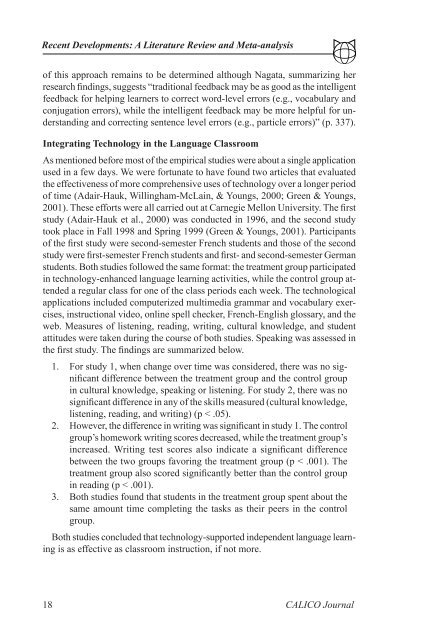Recent Developments in Technology and Language ... - CALICO
Recent Developments in Technology and Language ... - CALICO
Recent Developments in Technology and Language ... - CALICO
You also want an ePaper? Increase the reach of your titles
YUMPU automatically turns print PDFs into web optimized ePapers that Google loves.
<strong>Recent</strong> <strong>Developments</strong>: A Literature Review <strong>and</strong> Meta-analysis<br />
of this approach rema<strong>in</strong>s to be determ<strong>in</strong>ed although Nagata, summariz<strong>in</strong>g her<br />
research f<strong>in</strong>d<strong>in</strong>gs, suggests “traditional feedback may be as good as the <strong>in</strong>telligent<br />
feedback for help<strong>in</strong>g learners to correct word-level errors (e.g., vocabulary <strong>and</strong><br />
conjugation errors), while the <strong>in</strong>telligent feedback may be more helpful for underst<strong>and</strong><strong>in</strong>g<br />
<strong>and</strong> correct<strong>in</strong>g sentence level errors (e.g., particle errors)” (p. 33 ).<br />
Integrat<strong>in</strong>g <strong>Technology</strong> <strong>in</strong> the <strong>Language</strong> Classroom<br />
As mentioned before most of the empirical studies were about a s<strong>in</strong>gle application<br />
used <strong>in</strong> a few days. We were fortunate to have found two articles that evaluated<br />
the effectiveness of more comprehensive uses of technology over a longer period<br />
of time (Adair-Hauk, Will<strong>in</strong>gham-McLa<strong>in</strong>, & Youngs, 2000; Green & Youngs,<br />
2001). These efforts were all carried out at Carnegie Mellon University. The first<br />
study (Adair-Hauk et al., 2000) was conducted <strong>in</strong> 1996, <strong>and</strong> the second study<br />
took place <strong>in</strong> Fall 199 <strong>and</strong> Spr<strong>in</strong>g 1999 (Green & Youngs, 2001). Participants<br />
of the first study were second-semester French students <strong>and</strong> those of the second<br />
study were first-semester French students <strong>and</strong> first- <strong>and</strong> second-semester German<br />
students. Both studies followed the same format: the treatment group participated<br />
<strong>in</strong> technology-enhanced language learn<strong>in</strong>g activities, while the control group attended<br />
a regular class for one of the class periods each week. The technological<br />
applications <strong>in</strong>cluded computerized multimedia grammar <strong>and</strong> vocabulary exercises,<br />
<strong>in</strong>structional video, onl<strong>in</strong>e spell checker, French-English glossary, <strong>and</strong> the<br />
web. Measures of listen<strong>in</strong>g, read<strong>in</strong>g, writ<strong>in</strong>g, cultural knowledge, <strong>and</strong> student<br />
attitudes were taken dur<strong>in</strong>g the course of both studies. Speak<strong>in</strong>g was assessed <strong>in</strong><br />
the first study. The f<strong>in</strong>d<strong>in</strong>gs are summarized below.<br />
1. For study 1, when change over time was considered, there was no significant<br />
difference between the treatment group <strong>and</strong> the control group<br />
<strong>in</strong> cultural knowledge, speak<strong>in</strong>g or listen<strong>in</strong>g. For study 2, there was no<br />
significant difference <strong>in</strong> any of the skills measured (cultural knowledge,<br />
listen<strong>in</strong>g, read<strong>in</strong>g, <strong>and</strong> writ<strong>in</strong>g) (p < .05).<br />
2. However, the difference <strong>in</strong> writ<strong>in</strong>g was significant <strong>in</strong> study 1. The control<br />
group’s homework writ<strong>in</strong>g scores decreased, while the treatment group’s<br />
<strong>in</strong>creased. Writ<strong>in</strong>g test scores also <strong>in</strong>dicate a significant difference<br />
between the two groups favor<strong>in</strong>g the treatment group (p < .001). The<br />
treatment group also scored significantly better than the control group<br />
<strong>in</strong> read<strong>in</strong>g (p < .001).<br />
3. Both studies found that students <strong>in</strong> the treatment group spent about the<br />
same amount time complet<strong>in</strong>g the tasks as their peers <strong>in</strong> the control<br />
group.<br />
Both studies concluded that technology-supported <strong>in</strong>dependent language learn<strong>in</strong>g<br />
is as effective as classroom <strong>in</strong>struction, if not more.<br />
1 <strong>CALICO</strong> Journal
















